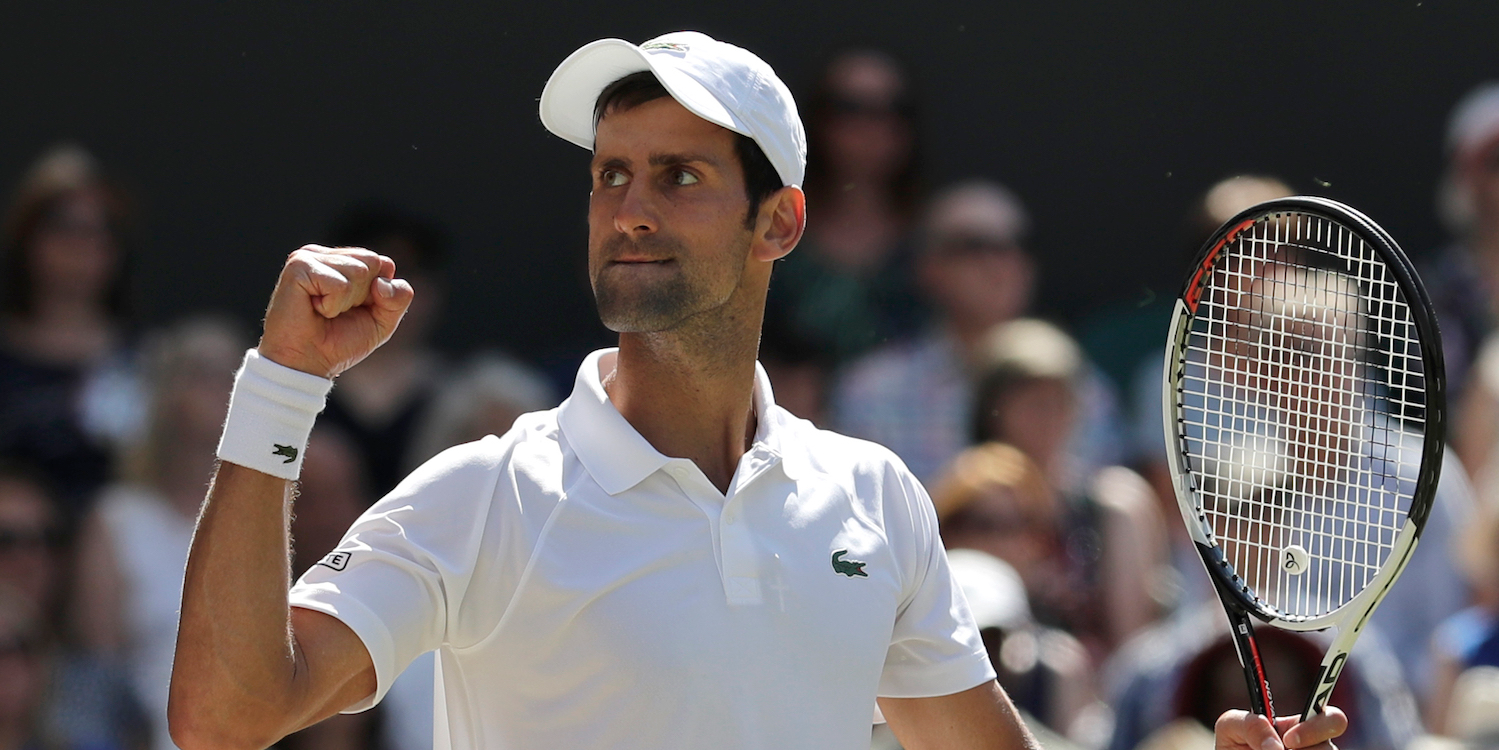- After one of the most dominant stretches in tennis history, Novak Djokovic fell into a major slump in 2017 that threatened his status in tennis.
- Djokovic had to get surgery on an elbow that was giving him trouble, but he also made several other key changes, from a change to his serve, a racket change, to mental changes.
- With two recent wins, including one at Wimbledon, Djokovic appears to be on the rebound and says he wouldn’t change anything from the tumultuous journey.
Novak Djokovic was dominating tennis until he wasn’t.
His 2015 season, considered one of the best in men’s history, included wins at the Australian Open, Wimbledon, and the U.S. Open, a final loss in the French Open, and wins in seven ATP Masters 1000 events.
He continued in 2016, with wins in the Australian Open and French Open. He made it to the U.S. Open final again but lost to Stan Wawrinka. It was as if everything unwound from there.
In 2017, Djokovic did not win any majors. He didn’t win any Masters 1000 events. He looked disjointed on the court, appearing at once flummoxed by his struggles, but also disinterested. He cycled through coaches, but nobody seemed to have the cure for him.
Of course, part of what ailed him was a nagging elbow injury, one he tried to play through.
"I actually probably could find a better solution without getting on the table for surgery if I addressed the elbow earlier, but I hadn't," Djokovic told an audience on Wednesday during a Q&A from the ASICS store in New York City. "I understood that the degree of the pain but you know how it is when you're in the machine of a professional sport - you just want to keep going.
"It came with an interest rate."
Djokovic skipped the 2017 U.S. Open to try and let his elbow heal. He took six months off to let it rest, then returned to the court without much success. After falling out of the Australian in the fourth round, Djokovic finally opted for surgery on his elbow, an operation he called "inevitable." But once again, he returned too soon, failing to win a match in his next two tournaments and exiting before the quarterfinals in his next five.
"I got back on the tour competing very early. I think too early. I wasn't ready," Djokovic said. "Even though I thought I was probably, mentally I was convinced that I'll be ready very soon ... ready to just play at the level that is required to compete with these guys for the major titles. I wasn't. I wasn't there."
And then something seemed to flip for Djokovic. He went to the semifinals at the Italian Open where he lost to Rafael Nadal. In June, he made it to the finals of the Fever-Tree Championships were he lost to Maric Colic. It was progress.
Then in July, he broke through with a stunning win at Wimbledon that required a two-day effort to beat Nadal in the semifinals, then a rousing three-set win over Kevin Anderson in the final.
In August, Djokovic won the Cincinnati Masters, giving him two wins in three tournaments, far and away his most successful stretch of tennis in over a year.
"The Wimbledon win and the Cincinnati win now are much sweeter and more special because of the journey that I've been through," Djokovic said.

On-court changes
Throughout his struggles, Djokovic was making changes. At the end of the 2017 season, Djokovic began tinkering with his serve with then-coaches Andre Agassi and Radek Stepanek.
Djokovic's serving tweaks focused on efficiency. He began going straight up with his racket arm, rather than dropping it down. He started focusing on specific spots where if he couldn't get an ace, he could at least have an advantage on the return.
"It's still a work in progress with the serve, to be honest," Djokovic said, adding: "I'm aware that I can't serve as the guys who are 6-foot-10. I'm not looking for that speed. I'm looking for precision, for accuracy, for strategic placement so I can actually have an easier first shot in a rally, or I can get better court position than my opponent. Technical details."
The numbers aren't jarring, but he's already had more aces in 2018 than he did in 2017, and his accuracy is up slightly.
Before surgery, he also worked on a new racket, changing the dimensions ever so slightly.
"Even though those are little minor changes that for someone who is not a pro would think, 'Well it's little bit larger head or different balance or swing weight, it doesn't really make a big difference.' But for me it does. I can feel that," he said.
"It took me, with the racket change, with the team change as well, and everything that was happening, it just took me 3-4 months to start playing the way I intended to play after the surgery, but obviously [it] didn't come right away."
Off-court changes

What Djokovic did off the court mattered, too. He began focusing on meditation and the importance of breathing and channeling his focus.
Djokovic has had moments where his temper or frustration derailed him on the court. He said he's been trying to get better at blocking out the surrounding circumstances and focusing on the moment.
"I think breathing is the most important thing that we all do, especially athletes," Djokovic said. "You have to master it in order to cope with pressure and those situations where it's very stressful. Even a guy like [Roger] Federer, who seems like nothing bothers him, I'm sure that he deals with a lot emotions inside, but he has mastered the control over those emotions and his mind, and that's why he's been so successful. You can see all the biggest athletes of the history of the sport, they all share that in common. Michael Jordan, this ability to just be in the zone when you need to. Your best surfaces when it's most important."
His current coach Marian Vajda also told reporters after Wimbledon that Djokovic made a slight change to his diet. Djokovic is famously gluten-free and avoids meat. However, his coach said it was necessary for him to take in more animal protein, so he began eating more fish.
"He has been given the right nutrition and is now compact. His muscles are perfect and physically feel great," Vajda said (via James Gray of The Express).
Trusting the process
Djokovic said through all of it that he learned how impatient he had been beforehand - that he wanted quick fixes when they weren't always available.
"I think one of the biggest things I've learned about myself is how impatient I was," Djokovic said. "And that was probably one of the hardest ways for me to learn how to be patient and to trust the process and to trust that things will come together when the time is right."
Djokovic's recent success has propelled him back to No. 6 in the world, and he enters the U.S. Open as the betting favorite because of his momentum. A win at the U.S. Open would not only propel Djokovic back into the conversation as one of the best players in the world, but it would also make a year that started so poorly one of the better seasons of his career.
"if I had the power to turn back time, I wouldn't change anything," Djokovic said. "I think it's absolutely everything has happened for a reason, and I have learned lessons and things about me on deeper levels and would never change anything."

